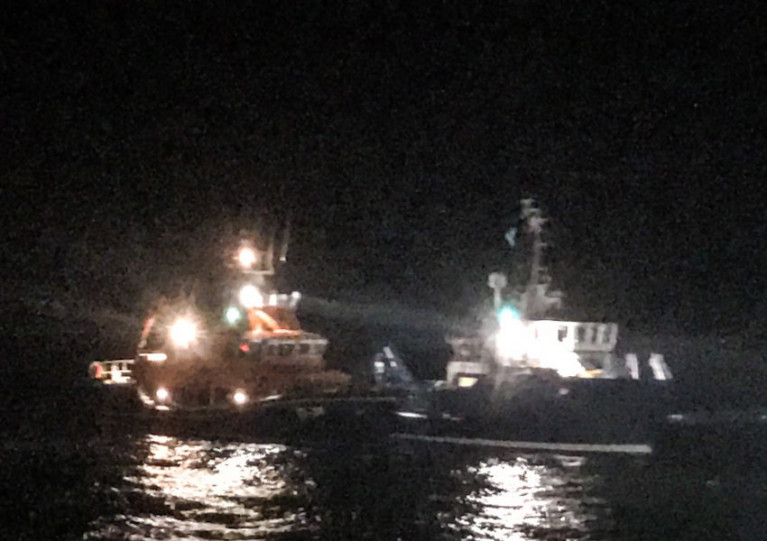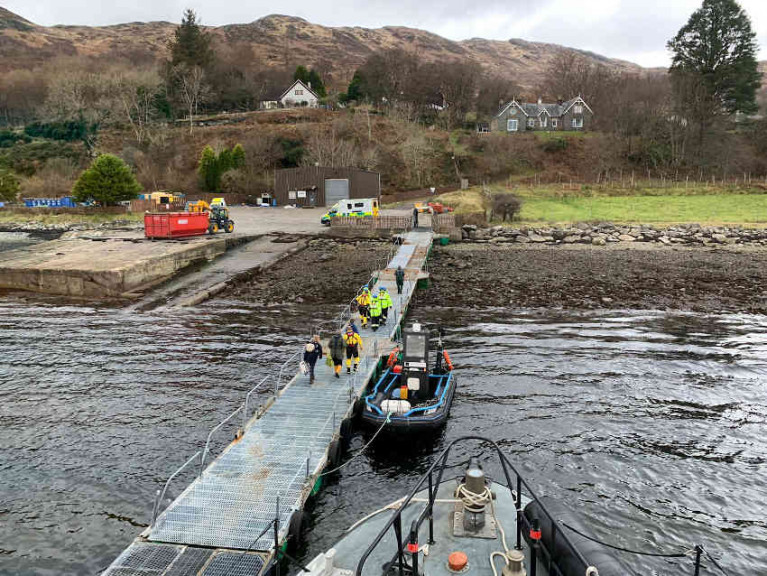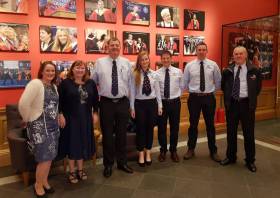Displaying items by tag: Tobermory
Pagers sounded for Largs RNLI’s volunteers yesterday afternoon (Thursday 27 May) after reports over VHF radio of a vessel on fire off Inverkip, on the Firth of Clyde in western Scotland.
The inshore lifeboat made best speed to the scene shortly after the 2.15pm alert, and on arrival learned that another boat had taken the crew from the casually vessel had them in tow to nearby Inverkip Marina.
It was established the crew of the casualty vessel had extinguished the fire and as the danger was now over, with no injuries reported, the lifeboat returned to station.
Much earlier yesterday, off Scoland’s east coast, Stonehaven RNLI launched the aid of a sailing vessel with engine problems.
The vessel was heading north under sail and had reached Dunnottar Castle, just south of Stonehaven, when the wind dropped at around 1am. Attempts were made to start the engine, but these were not successful.
 The crew of the inshore lifeboat Jamie Hunter escort a sailing vessel with engine trouble into Stonehaven Harbour | Credit: RNLI
The crew of the inshore lifeboat Jamie Hunter escort a sailing vessel with engine trouble into Stonehaven Harbour | Credit: RNLI
As concerns grew that the tide might pull the boat towards the rocky coast, the UK Coastguard called out the station’s inshore lifeboat Jamie Hunter, which was launched at 4am.
After reaching the vessel and confirming its two crew members were safe and well, Largs RNLI put mechanic Paul Sim on board to assess the situation and he was able to get limited power from the engine — which allowed the vessel to be escorted into Stonehaven Harbour just after 7am.
Speaking just after the callout, lifeboat helm Andy Martin said: “It was certainly an early morning pager call for our volunteer crew, and they quickly got to the scene.
“It had the potential to become quite dangerous for the sailing vessel, but Paul’s mechanical experience and expertise came in very handy.
“We are pleased to have been able to help and the situation worked out with everyone recovered safe and well.”
In other lifeboat news from Scotland, Tobermory RNLI launched on Wednesday (26 May) following a report of a semi-submerged kayak with a dry bag in Sanna Bay, Ardnamurchan.
 File image of Tobermory RNLI’s Severn Class lifeboat | Credit: RNLI/Sam Jones
File image of Tobermory RNLI’s Severn Class lifeboat | Credit: RNLI/Sam Jones
Stornoway Coastguard confirmed that the kayak had been reported to have been washed out to sea from Loch Scavaig on the Isle of Skye and that there were no missing persons.
The lifeboat crew recovered the kayak and dry bag and transported them to Kilchoan where they were left in the care of the local Coastguard Rescue Team.
The shout came six days after a callout to a yacht which had lost its drive in the Sound of Mull last Thursday evening, 20 May. The lifeboat met the yacht at the entrance to Tobermory Bay and, using an alongside tow, assisted it to berth at the harbour pontoons.
Tobermory RNLI station coxswain David McHaffie said: “In both of these incidents, the people involved made the correct call and contacted the coastguard so that we were able to respond in good time. We would much rather be called out too early than too late.”
Tobermory RNLI's volunteer crew rushed to the aid of a 23m fish farm support vessel with the misfortune to have an engine fire on the evening of Friday 13 March.
After putting out a ‘Pan Pan’ alert, the crew managed to get the fire under control. But in doing so, they were forced to shut down both engines and were drifting about a mile from the treacherous Ardnamruchan coast in western Scotland without any power.
Tobermory RNLI’s volunteer crew received an immediate launch page at 5.32pm and the lifeboat was underway just 13 minutes later, making best speed to the casualty vessel.
The crew passed a line to the vessel and she was towed towards Tobermory in relatively good conditions.
However, just after dropping the tow rope and securing the fish farm vessel for an alongside tow, the wind picked up significantly which made manoeuvring the much larger vessel a challenge for the lifeboat and her crew.
Nevertheless, the vessel was successfully put alongside the aquaculture pontoon in Tobermory where local coastguard rescue teams and staff from the Tobermory Harbour Authority were able to help secure her.
This was the first ‘shout’ for deputy coxswain Dave Underwood who only qualified as a coxswain in late January, and this was only his second weekend on call.
Lifeboat operations manager Dr Sam Jones said: “We’re extremely pleased that the crew of the fish farm vessel managed to get the fire under control so quickly and that no one was hurt.
“Given the nature of the emergency and the size of the vessel, this would be an extremely challenging shout for any coxswain, let alone a relatively new one. Dave certainly had a baptism of fire in more ways than one on Friday the 13th.”
Tobermory RNLI’s volunteer crew took part in a multi-agency operation to evacuate an injured man from a local fish farm yesterday morning, Wednesday 5 February.
Following the report of a crush injury at the fish farm in the Sound of Mull, Tobermory RNLI’s volunteer crew launched their Severn class all-weather lifeboat, Elizabeth Fairlie Ramsey, shortly after 10am.
The crew collected two Scottish Ambulance Service personnel and a member of the local coastguard rescue team, and proceeded to the fish farm by MacLean’s Nose on the south coast of Ardnamurchan, near to Kilchoan.
Having stabilised the injured man, the lifeboat returned to Tobermory where the crew were met by other members of the local coastguard team and Police Scotland.
The casualty was transferred to a waiting ambulance before being taken to Tobermory Golf Club for a further transfer to the air ambulance, Helimed 5, which then flew the man to Glasgow for hospital treatment.
Lifeboat operations manager Dr Sam Jones said: “This was another great example of multi-agency working between the emergency services in our local community and beyond.
“We’d like to thank all those at the fish farm who gave immediate first aid on scene and all of us at the station wish the injured man a very speedy recovery.”
This was also the first shout for one of Tobermory RNLI’s newest recruits, Jenny Hampson, a project manager for the Tobermory Harbour Association.
Tobermory Lifeboat’s ‘Kiwi’ Is New World Mince & Tatties Champion
Tobermory RNLI’s deputy second mechanic Tony ‘Kiwi’ Spillane has been announced as World Mince and Tatties Champion for 2020.
After the All Blacks' disappointing run in the Rugby World Cup last year, the New Zealander made his home country proud by emerging victorious in the contest at the Mishnish in Tobermory yesterday, Saturday 25 January.
‘Kiwi’ has continued in a tradition of world champions at the lifeboat station, on the Isle of Mull in western Scotland, with operations manager Dr Sam Jones winning the title in 2007 and former coxswain Phil Higson being champion in 2008 and 2011.
Competitors submit their best plate of mince and tatties to a panel of judges, with the winner being declared world champion.
But there was controversy when it emerged that coxswain David McHaffie and Dr Sam Jones had been two of the three judges, and some of the audience claimed that there had been ‘a fix’.
But Dr Jones dismissed the accusations. “Kiwi won his world title absolutely fair and square,” he said. “It was a blind tasting and none of us had any idea whose mince we were sampling.
“We’re hoping that at our next training night, Kiwi will cook up his championship dish to warm up the volunteer crew when they come back from exercise.”
New Year’s Day Medevac From Remote Island For Tobermory Lifeboat
Tobermory RNLI’s volunteer crew had their first shout just 12 hours into 2020 when they went to assist a seriously injured casualty on a remote island in Loch Sunart in the western Scottish Highlands.
The pagers sounded just before midday on Wednesday 1 January and the volunteer crew were tasked by the UK Coastguard to carry out a medical evacuation, or medevac, from the island of Carna for a casualty who had fallen down a flight of stairs.
Tobermory's Severn class lifeboat was launched and the crew collected two Scottish Ambulance Service paramedics from Laga Bay before heading to the island.
Two lifeboat crew members accompanied the paramedics ashore to attend the casualty. After receiving treatment at the scene, the casualty was transferred to the lifeboat which then returned to Laga Bay for a further transfer to the waiting ambulance with the assistance of Salen Coastguard Rescue Team.
The lifeboat returned to Tobermory where it was refuelled and made ready for service shortly before 4pm.
Tobermory RNLI coxswain David McHaffie said: “This was a real team effort with our colleagues from the Scottish Ambulance Service and Salen Coastguard. All of us at the lifeboat station wish the casualty a speedy recovery.”
Prestigious Awards For Volunteering Go To Scottish Lifeboat Stations
Volunteers at Oban and Tobermory’s RNLI lifeboat stations in eastern Scotland have been recognised for their invaluable service in this year’s Excellence in Volunteering Awards.
Oban’s four deputy coxswains — Mark Scott, Finlo Cottier, David Isaac and James Hardie — have all been recognised by the RNLI for their dedication to the station.
The certificates awarded by the RNLI’s chairman and council recorded their “sincere thanks” for “giving time to help provide full time coxswain cover at the station” and for their “commitment and leadership”.
In addition, the Argyll station’s press officers Iain Fulton and Leonie Mead also received awards for their “invaluable support to Oban Lifeboat Station”.
Meanwhile, Tobermory Lifeboat Station — nearby, on the Isle of Mull — received an Excellence in Volunteering Award earlier in the autumn following an operational evaluation carried out by an independent RNLI team of assessors.
The award recognised the crew’s “invaluable service to the institution” and that “with a committed management team and crew fully engaged in all aspects of the station, your focused team efforts, camaraderie and professionalism are greatly appreciated”.
Tobermory lifeboat operations manager Dr Sam Jones also received an award in recognition of her “invaluable service” to the station, of her “outstanding contribution” and for “making a positive impact at the station, engaging the crew and providing safe and effective leadership”.
Full-time coxswain David McHaffie and mechanic Paul Gunn have also received staff awards in recognition of their leadership and dedication at the station.
The RNLI’s prestigious Excellence in Volunteering Awards recognise both staff and volunteers who have gone above and beyond what is expected of them.
Members of both stations attended a celebratory dinner at the Playfair Library in Edinburgh on Saturday 16 November, hosted by the RNLI’s chairman Stuart Popham and Scottish chairman Roger Lockwood.

The dinner rounded off a busy week for Tobermory RNLI. Members of the crew represented the station at the previous weekend’s Remembrance events in Tobermory, including the community commemoration, ‘Mull Remembers’, on Saturday 9 November and Sunday’s service at Tobermory Parish Church and wreath-laying at the war memorial.
Tobermory’s RNLI shop and fundraising branc,h along with some members of the crew, also hosted a mince pie and coffee morning at the Aros Hall on Saturday 16 November. This well-attended annual event took over £600 in shop sales and an incredible £508 from a raffle and donations.
McHaffie said: “The awards to the station recognise the hard work of everyone involved, particularly our volunteers who give up so much of their free time, not only for training and carrying out rescues, but also for helping to make the station run effectively and efficiently.
“I’m pleased that some partners of the crew were also able to attend the celebratory dinner in Edinburgh as we couldn’t operate without the support of our families and friends.”




























































